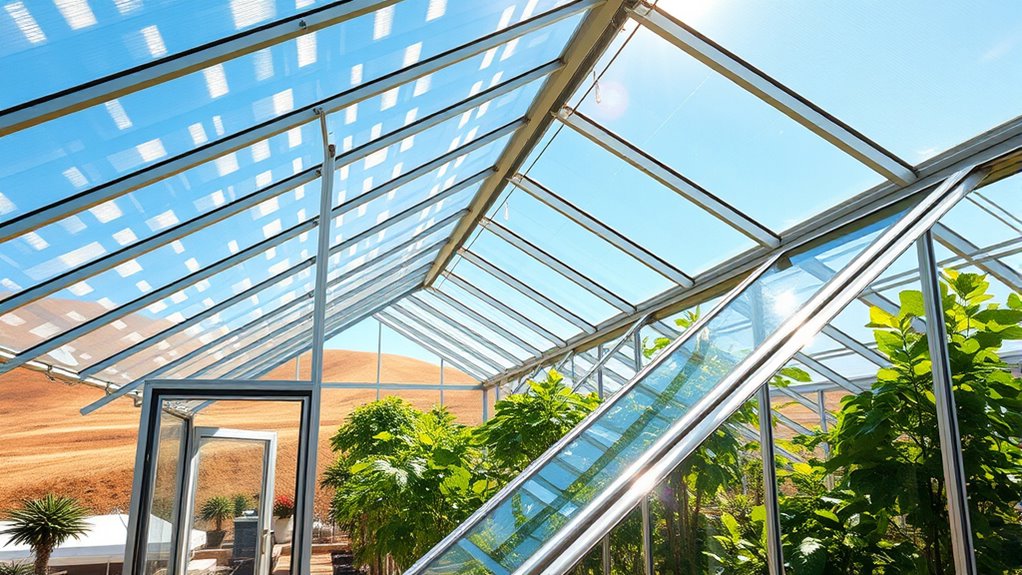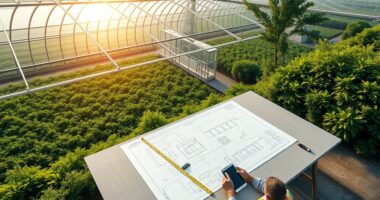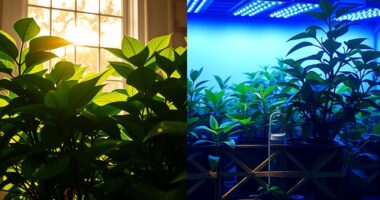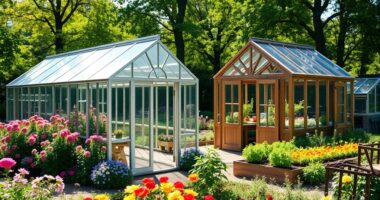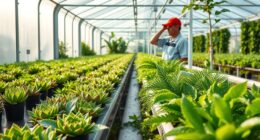To get the most sunlight for your greenhouse, position it along an east-west axis so the longest side faces south. This setup ensures your plants receive even and maximum light throughout the day, which is especially helpful during shorter winter days. Make sure the site is free from shadows cast by trees or structures and offers good exposure for sunlight. Keep exploring for more tips on choosing the perfect location to boost your greenhouse’s performance.
Key Takeaways
- Orient the greenhouse along an east-west axis to maximize sunlight exposure throughout the day.
- Position the longer side facing south if a different orientation is necessary, to optimize light intake.
- Place the greenhouse in an area with minimal shade from trees or structures during peak sunlight hours.
- Ensure the site is on flat, well-drained terrain to prevent shadows and promote even light distribution.
- Choose a location with unobstructed sunlight during winter months, when daylight is shorter.
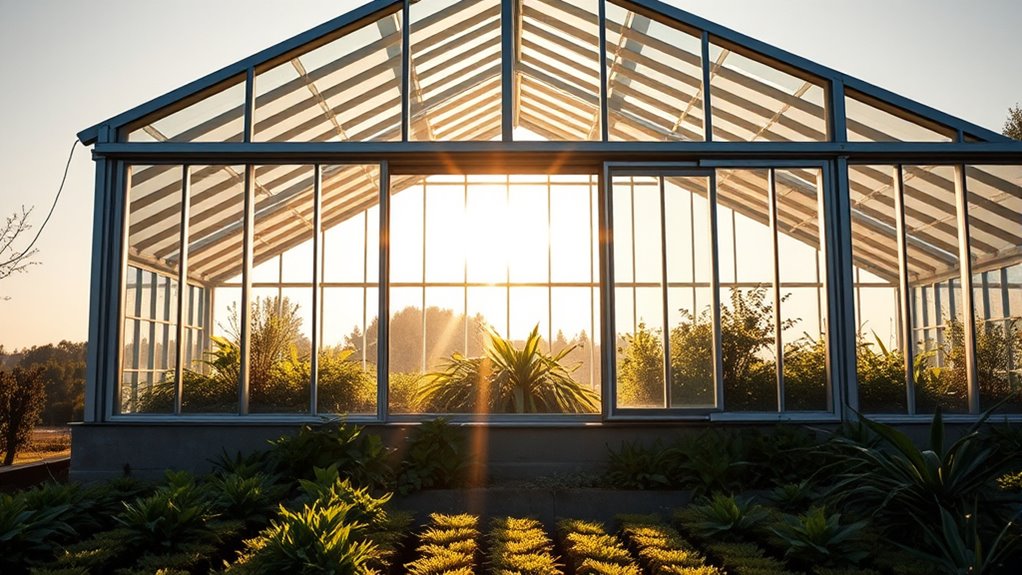
Selecting the appropriate site for your greenhouse is essential to guarantee your plants receive sufficient light throughout the day. When choosing a location, you need to consider shade considerations, as nearby trees, buildings, or other structures can block sunlight during critical hours. Ideally, your greenhouse should be placed in an area that receives direct sunlight for the majority of the day, especially during winter months when daylight hours are shorter. Avoid shaded spots or areas with tall objects that cast shadows over the structure, because even partial shade can markedly reduce plant growth and productivity.
Choose a sunny, unobstructed site for your greenhouse to maximize light and plant growth.
In addition to sunlight, wind protection plays a crucial role in greenhouse placement. Strong winds can not only shake the structure but also cause temperature fluctuations that stress your plants. Place your greenhouse in a location sheltered from prevailing winds, such as near a natural windbreak like a fence, hedge, or existing building. This reduces wind exposure, helping maintain stable temperatures and minimizing structural strain. Proper wind protection also prevents debris from damaging the glass or plastic panels and keeps your workspace safer and more comfortable.
Another key consideration is orientation. For maximum light exposure, orient your greenhouse along an east-west axis. This allows the northern and southern sides to receive even sunlight throughout the day, optimizing light distribution inside the structure. If your site only allows for a different orientation, prioritize positioning the longer side facing south to catch the most sunlight. This is especially important if you’re in a region with shorter winter days, as it ensures your plants get as much light as possible during the critical growing season.
The terrain of your chosen site also matters. A flat, well-drained area prevents water pooling, which can lead to damp conditions and affect plant health. Avoid low-lying spots where cold air and frost tend to settle or areas prone to flooding. Elevated sites are often preferable because they promote better drainage and reduce frost risk, helping your plants thrive year-round. Additionally, considering the placement and design of your greenhouse can influence how effectively it captures and utilizes sunlight, further enhancing plant growth.
Finally, think about accessibility and proximity to water sources and utilities. While not directly related to light, these factors influence how easily you can maintain and monitor your greenhouse. A well-located site ensures you can efficiently manage watering, heating, and ventilation, supporting your overall growing success. By carefully considering shade considerations, wind protection, orientation, terrain, and accessibility, you set a strong foundation for a thriving greenhouse that maximizes natural light and protects your plants from environmental stressors.
Frequently Asked Questions
How Does Surrounding Vegetation Affect Greenhouse Sunlight Exposure?
Surrounding vegetation can considerably impact your greenhouse’s sunlight exposure. Dense vegetation may block sunlight, reducing the amount of light that reaches your plants. Wind blockages from tall trees or shrubs can also create shade and limit airflow, which affects light and temperature regulation. To maximize sunlight, clear or trim nearby vegetation, especially if it’s dense or tall enough to cast shadows during peak sunlight hours.
Can Reflective Surfaces Improve Light Inside the Greenhouse?
Reflective surfaces can markedly boost light inside your greenhouse, increasing light enhancement by up to 30%. You should consider installing reflective materials like white paint, aluminum foil, or reflective panels around your structure. These surfaces bounce sunlight, ensuring even distribution and maximizing exposure during cloudy days or low-angle sunlight. By doing so, you’ll create a more consistent and brighter environment, promoting healthier plant growth and potentially extending your growing season.
What Impact Does Nearby Tall Structures Have on Sunlight Access?
Nearby tall structures can considerably impact your greenhouse by creating urban shadows, which lead to sunlight obstruction. These shadows reduce the amount of direct sunlight that reaches your plants, potentially hindering growth. To maximize light, you should position your greenhouse away from such structures or choose a location with minimal obstruction. Regularly monitor sunlight patterns, especially during different seasons, to guarantee your plants receive adequate light for healthy development.
How Does Climate Influence Optimal Greenhouse Orientation?
Climate influences your greenhouse orientation markedly. In colder climate zones, you should orient it to maximize sunlight hours, usually facing south to capture the most winter sun. Conversely, in warmer or more temperate zones, you might tilt or position it differently to avoid overheating. Consider your local climate’s sunlight patterns and seasonal variations to choose the best orientation, ensuring your plants get consistent, ideal light year-round.
Is Seasonal Sunlight Variation Considered in Greenhouse Placement?
Think of your greenhouse as a sun-loving plant that adapts to changing seasons. You should consider seasonal sunlight variation because it affects sunlight duration and seasonal shading. By positioning your greenhouse to maximize winter sunlight and reduce summer shade, you guarantee year-round peak light. This way, your plants thrive through the seasons, just like a well-timed dance with the sun’s shifting path across the sky.
Conclusion
By carefully choosing your greenhouse’s orientation and placement, you can maximize sunlight just like a sunflower turns to the sun. Position it to face south or southeast to catch the most rays throughout the day. Remember, a well-placed greenhouse isn’t just about convenience — it’s about harnessing nature’s power to grow healthy, thriving plants. With thoughtful planning, you’ll create a bright, welcoming space that captures the sun’s energy, fueling your gardening success.
